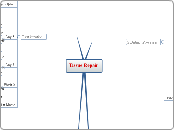arabera Chan Samuel 17 years ago
1067
Tissue Repair

arabera Chan Samuel 17 years ago
1067

Honelako gehiago
Fibrous granulation tissue
Inconspicuous capillaries and numerous plump activated fibroblasts
Vascular granulation tissue
Loose connective tissue matrix
Proliferating fibroblasts
Leukocytes
Resolving inflammation
Wound Healing
Fibroblast with smooth muscle characteristics
mediated by myofibroblast
Skeletal muscle
Cardiac muscle
Neurons
4) Remodelling of Fibrous Tissue
Vascular regression continues as scar matures
Conversion of granulation tissue into scar
Dense collagen
Spindle shaped fibroblasrt
3) Deposition of ECM
Fibroblast proliferation decreases over time while ECM deposition increases
major portion of connective tissue formed by fibrillar collagens
2) Migration + Proliferation of Fibroblasts
Formation of granulation tissue framework
Proliferation triggered by GFs and Cytokines
1) Angiogenesis
d) Recruitment of periendothelial cells
Smooth muscle cells
Pericytes
c) Maturation of Cells
Inhibition and remodeling into capillary tubes
b) Migration and proliferation of Endothelial Cells
To angiogenic stimulus
a) Proteolytic Degradation
BM of parent vessel
Needs intact basement Membrane
Cells proliferate haphazrdly if BM disrupted
Needed for organized regeneration
Underlying supporting stroma of parenchymal cells
Stable Cells
Quiescent cells
E.g.
Parenchymal cells of glandular organs
Vascular endothelial cells
Mesenchymal cells
Considered to be G0 but can be stimulated into G1
Capable of rebuilding tissue of origin
Rapid division in response to stimuli
Normally low level or replication
Labile Cells
Stratified sq. cells of skin, columnar epithelium of GI tract
Regen. derived mostly from stem cells with unlimited regen capacity
Continuously dividing cells
Proliferate to replace cells
Follow cell cycle from one mitosis to the next